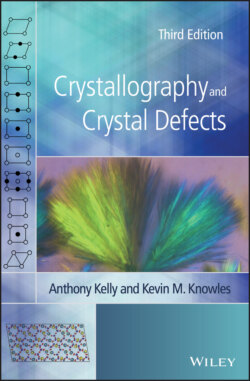Читать книгу Crystallography and Crystal Defects - Anthony Kelly - Страница 32
2.3 Tetragonal System
ОглавлениеThe tetrad axis is always taken parallel to the z‐axis. The lattice parameters a and b are equal.
The holosymmetric point group is 4/mmm, showing three mutually perpendicular mirror planes with a tetrad normal to one of them (Figure 2.6). If a single pole is repeated according to the presence of these symmetry elements it will be found that diad axes are necessarily present normal to the mirrors and that, in addition, a second pair of diad axes also normal to mirror planes automatically arises. One of the pairs of mutually perpendicular diads is chosen as defining the directions of the x‐ and y‐axes. The general form is {hkl}, with a multiplicity of 16. Special forms are {001}, {100}, {110}, {hk0}, {h0l} and {hhl}. The last of these, {hhl}, indicates a face making equal intercepts on the x‐ and y‐axes.
The point group 422 could be specified simply as 42 since if 4 and 2 are present at right angles a second pair of diad axes arises and one of these pairs is chosen to define the x‐ and y‐axes. The group m can be developed as m. It is then found that diad axes automatically arise at 45° to the two, mutually perpendicular, mirror planes. The pair of diad axes is taken to define the x‐ and y‐axes. The four other tetragonal point groups, 4, , 4/m and 4mm, are straightforward and no diad axes arise.
The angles between poles on a stereogram and the ratio of the lattice parameters (i.e. the ratio a : c in this crystal system) are easily related by using equations such as those in Eq. (2.1) with a = b.
